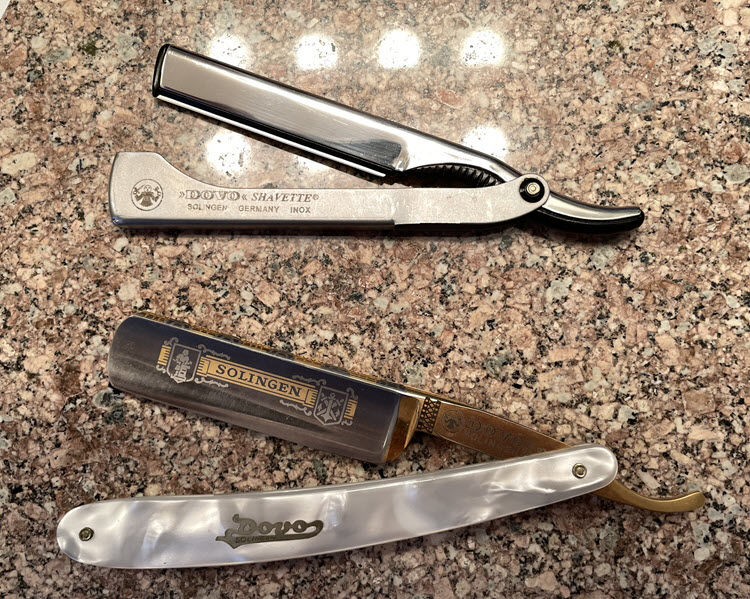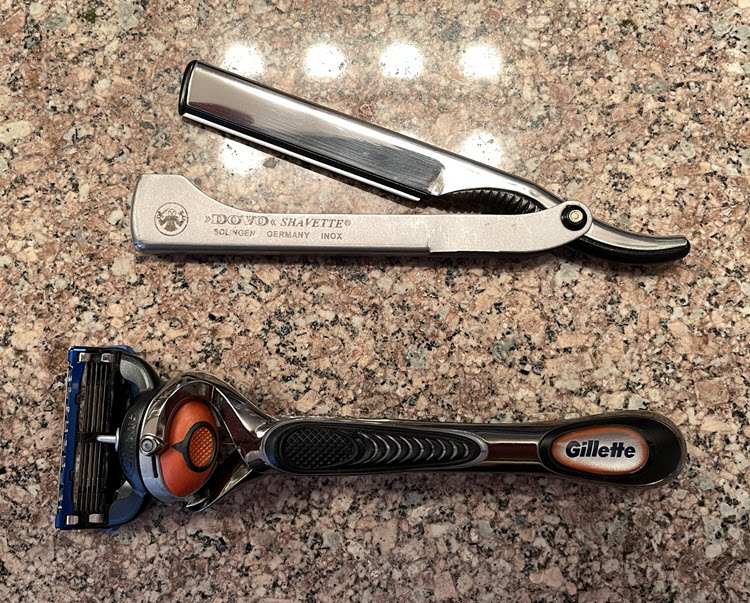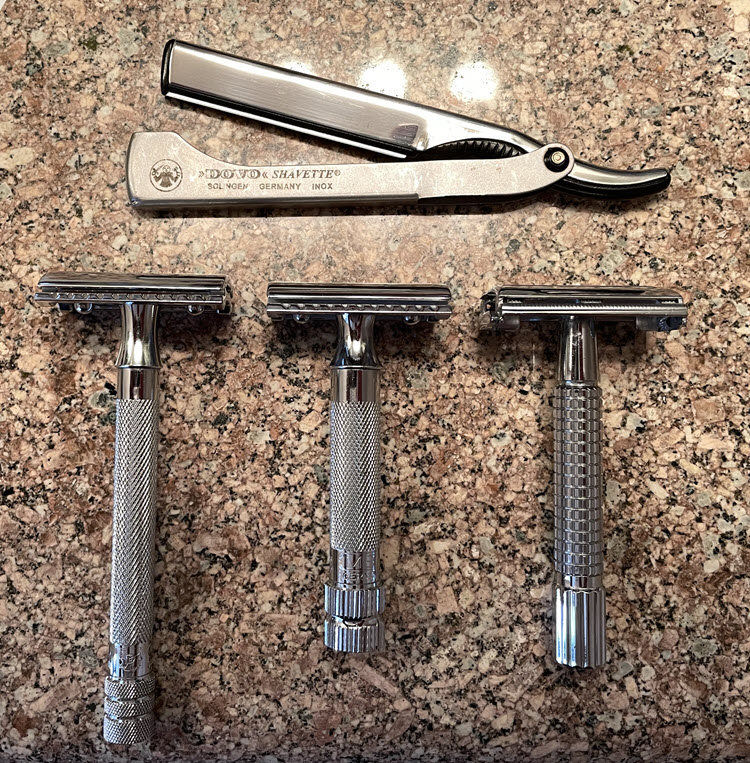 Photo 118087992 © Lakesdesign | Dreamstime.com
Photo 118087992 © Lakesdesign | Dreamstime.com
If you’re new to the wet shaving world, then you might be wondering: What is a shavette? A shavette is a folding razor that takes a disposable blade. It has a very similar look and feel to a straight razor and you shave with it in much the same way as a straight razor. The cutting edge of the razor folds into the handle.
Most shavettes take the same razors that double-edge (DE) / safety razors use. In some cases the DE blade is snapped in half and used, but in some cases the entire blade is used. The blade is typically held in place with some type of insert or is clamped between two pieces of metal with a locking mechanism to hold it in place. The latter can be seen in the above photo..
Shavette vs Straight Razor

Dovo shavette and straight razor
Advantages
Replaceable Blade – The best advantage a shavette has over a straight razor is the fact that it takes a disposable/replaceable blade. You don’t have to hone the razor or pay someone to hone it for you, you don’t have to strop it before each shave. You just pick it up and shave with it. Similarly, when the blade gets dull you just pop it out and put in a new one. “Easy peasy” like some people I know say.
Less Expensive – Another advantage is that shavettes are generally cheaper than straight razors. Generally you’re looking at tens of dollars to purchase a shavette versus one hundred or more dollars to purchase a straight razor. There are some exceptions like the feather razors which cost about the same amount as a quality straight razor, but most shavettes are a lot more affordable.
Don’t Have To Worry If the Edge is Sharp – Finally, there are fewer variables at play when learning to shave with a shavette versus a straight razor. However, this is only applicable if you’ve never shaved with either one. When learning to shave with a shavette or straight razor, you will have to hold an object you’ve never held before and do movements with it you’ve never done before.
With a shavette you only have to focus on holding it correctly and at the right angle in order to shave your beard or hair. With a straight razor you have the added complication of not knowing if the shaving edge is sharp enough. This can largely be mitigated by buying a shave ready straight razor and not stropping it before use.
However, if purchasing a brand new razor is out of reach and you’re honing/stropping it yourself, then it can be quite the conundrum to know whether you’re not able to shave your beard/hair due to poor technique or because the shaving edge isn’t sharp enough.
Disadvantages
Not As Much Heft – Shavettes can be extremely light depending on the type of shavette you purchase. Most straight razors have more weight to them which makes it easier to cut through your hair. I read once online where someone compared to shaving with a Dovo Shavette to shaving with an aluminum can that’s been cut in half which to a certain extent I can agree. I definitely prefer the feel of shaving with a straight razor to the feel of shaving with a shavette.
Easier To Nick Yourself – Another disadvantage that a shavette has is that it might be easier to nick yourself than with a straight razor. DE blades are machine sharpened and have quite a sharp edge on them. In my experience, I feel like I can feel when I’m about to nick myself with a straight razor and make adjustments to avoid drawing blood, but with shavettes I don’t feel like I have that same man-blade connection.
Possibly More Expensive Over The Long Term – Since you have to buy replacement blades, there is a possibility it might be more expensive over the long term. However, straight razors have their own maintenance costs, so a careful analysis would have to be conducted to evaluate which one is truly less expensive.
Shavette vs Cartridge Razor

Dovo Shavette and a Gillette Fusion Proglide w/ Flexball handle.
Advantages
Blades Are Cheaper – Since cartridge razors and shavettes both use disposable/replaceable blades they’re the same in that regard. Where the shavette has the advantage is that shavettes use safety razor blades, also called DE blades, which can be bought for a lot less than cartridge razors. This amounts to a much cheaper shave especially when you take into account that a lot of shavettes only use one-half of a DE blade.
Of course you have to take into account how many shaves you can get per DE blade versus how many shaves you can get with a cartridge razor. However, my experience has been that DE blades are a cheaper way to shave than cartridge razors.
Shave Longer Lengths of Hair – Another advantage of shavettes is that you can shave longer lengths of hair without running into the clogging issues that you get with cartridge razors.
In shaving tests I performed with a cartridge razor I found that with eleven days of beard growth my shave time doubled from around the 3-minute mark to around 7 minutes. This is largely due to the extra time spent trying to get the longer hairs free that are wedged between the cartridge razor blades.
Shavettes only have one blade, so you don’t really run into the issue. To be fair, hair can get stuck between the blade holder and the shavette blade, but it’s much easier to deal with than with a cartridge razor.
Disadvantages
Bigger Learning Curve / Easier to Nick Yourself – The biggest disadvantage a shavette has compared to a cartridge razor is the ease of use. Cartridge razors are simply easier to use and don’t take much effort or experience to shave with whereas shavettes have a learning curve and it’s very easy to nick yourself if you’re not careful. Also, you’re all but guaranteed to nick yourself at some point when using a shavette.
Shavette vs Safety Razor / DE Razor

Dovo shavette with three safety razors.
Advantages
Learned Muscle Memory Transfers to Using Straight Razors – I would have to say shavettes and safety/DE razors are pretty much neck in neck. The only advantage a shavette may have over a safety razor is that you will develop muscle memory using it that can later be applied to using a straight razor. While shaving with a straight razor is definitely different than shaving with a shavette, there is enough overlap to make a shavette a good stepping stone to a straight razor.
Less Awkward To Hold Once You Learn How to Use It – Another advantage to shavettes I came up with is that safety razor / DE razors tend to have short handles. This can make them a little awkward to use especially compared to shavettes after you have developed the requisite muscle memory to use them.
Disadvantages
Larger Learning Curve – Although safety/DE razors do have a slight learning curve, I do think it’s easier to learn to shave with a safety razor than a shavette. A safety razor is closer to a modern cartridge razor which most men have spent years using. These years of experience can be applied to the use of a safety razor where they can’t really be applied to the use of a shavette.
Conclusion
Shavettes can be a cost effective way to get a similar shaving experience to using a straight razor without the added maintenance of honing and stropping. The blades are cheaper than cartridge razors. Shavettes are pretty neck and neck with safety razors, but they have a hand up if you ever want to use a straight razor in the future.
Have you ever used a shavette? What was your experience? Leave your comments below and I’ll be sure to get back to you.